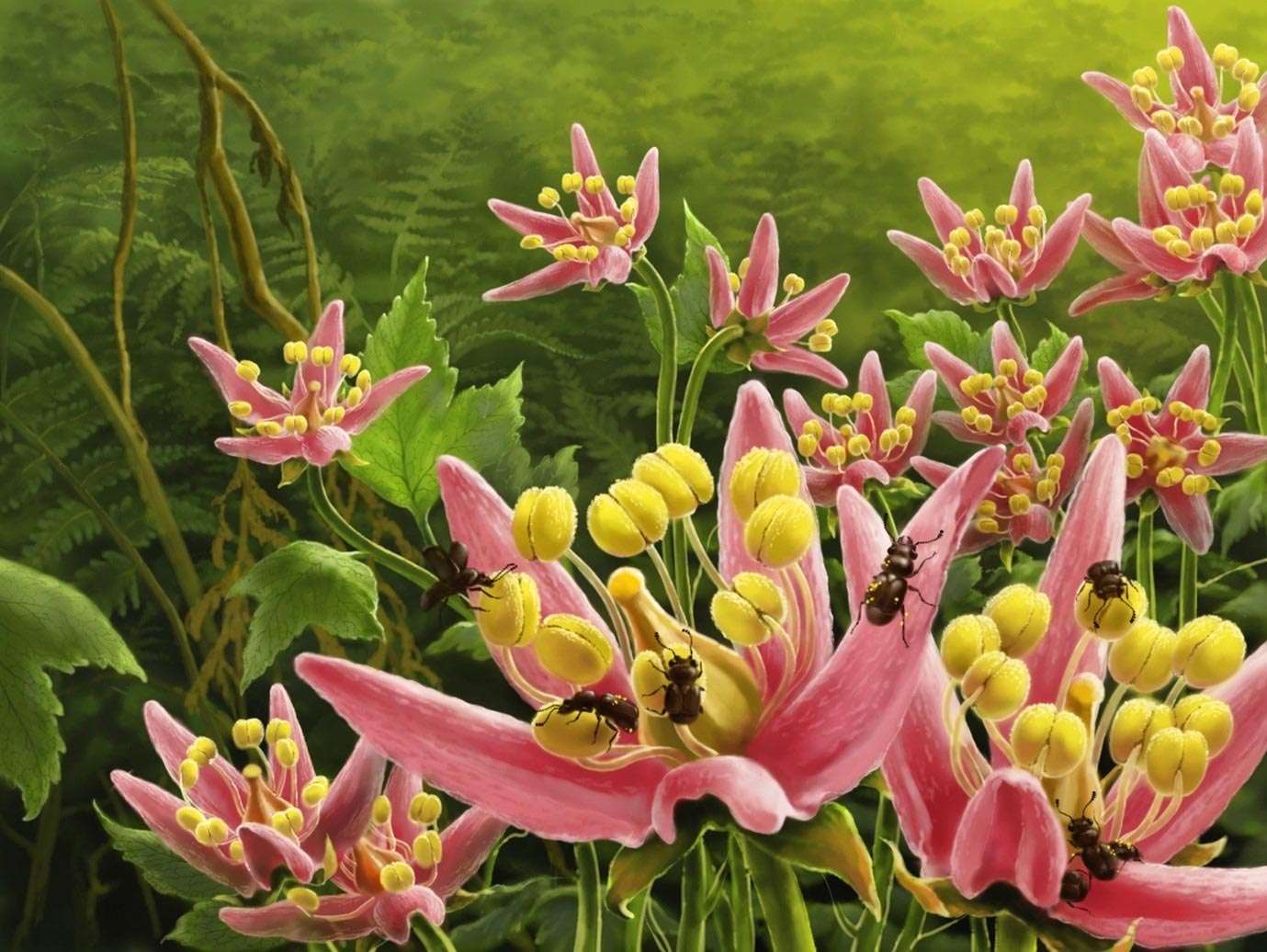
Ecological reconstruction of Pelretes vivificus establishing angiosperm flowers in the Burmese amber forest (~ 99 Ma). Credit: Artworks by mr. Jie Sun
An amber fossil of a Chalk beetle shed some light on the diet of one of the earliest pollinators of flowering plants.
The remains of the animal were found by researchers at the University of Bristol and the Nanjing Institute of Geology and Paleontology of the Chinese Academy of Sciences (NIGPAS) which was able to study the fossil fecal matter, which was composed only of pollen.
In addition to being a visitor to angiosperms – flowering plants – researchers now have evidence that the new fossil called Pelretes vivificus also fed on their pollen. Details of this discovery are in today Natural plants.
‘The beetle is associated with clusters of pollen grains, indicating that short-winged flower beetles visited angiosperms in the Cretaceous. “Some aspects of the beetle’s anatomy, such as the hairy belly, are also adaptations related to pollination,” said Professor Chenyang Cai, paleontologist at the School of Earth Sciences and NIGPAS.

Aggregations of eudicot pollen and pollen-containing coprolites associated with Pelretes vivificus. a, Amber piece with P. vivificus, showing coprolites and one pollen aggregation. details of pollen under visible light (d) and confocal laser scanning microscopy (b, c, e). Scale bars: 1 mm (a), 50 μm in (b, e), 100 μm (c, d). Credit: Chenyang Cai, Yanzhe Fu and Yitong Su
Erik Tihelka, entomologist and paleontologist at the School of Earth Sciences, added: “The fossil is associated with beetle coprolites – fossil fecal grains – which provide a very unusual but important insight into the diet of short-winged flower beetles in the Cretaceous. The fossil fecal granules are composed entirely of pollen, the same species found in clusters around the beetle and attached to its body. We therefore know that Pelretes visited angiosperms to feed their pollen. This finding provides a direct link between early flowering plants in the Cretaceous and their insect visitors; it shows that these insect fossils were not only preserved together with pollen, but that there was a real biological connection between the two. ”
While pollinators such as bees and butterflies today provide important ecosystem services, little is known about the origin of the intimate relationship between flowering plants and insects.

Dorsal view of Pelretes vivificus, a short-flowered beetle (Kateretidae) of the Burmese amber (~ 99 Ma). Scale bar: 200 μm. Credit: Chenyang Cai, Yanzhe Fu and Yitong Su
Amber fossils from the Cretaceous are an important source of evidence for understanding the biology of early angiosperms before they became the dominant group of plants on earth. Amber is the fossil resin of ancient trees that was often accidentally trapped by insects and other small organisms, and preserved with fidelity to life.
“Farmers who want to protect their orchards can put traps on trees to monitor insects. Now imagine that your only insight into an ancient ecosystem was such tough traps and that you would construct all of its ecological interactions based solely on this evidence. This is the challenge that paleontologists study amber with, ”explains Tihelka. ‘Fortunately, the amber trap from northern Myanmar is one of the richest fossil-like amber deposits. “Apart from the unparalleled abundance of fossil insects, the amber dates from the middle of the Cretaceous, exactly when angiosperms rise,” said Mr. Tihelka said.
Two hundred million years ago, the world was as green as it is today, overgrown with dense vegetation. But it was not so colorful – there were no flowers. Flowering plants that today make up more than 80% of all plant species only began to diversify in the Cretaceous about 125 million years ago. Some scientists have attributed the great evolutionary success of angiosperms to their interrelationships with insect pollinators, but fossil evidence of the Cretaceous pollinators has so far been scarce.
The flower beetle Pelretes vivificus lived in the Burmese amber rainforest about 98 million years ago. Its closest relatives are short-winged flower beetles (Kateretidae) found in Australia today, which visit a variety of flowers and feed their pollen.
“The pollen associated with the beetle can be attributed to the fossil genus Tricolpopollenites. This group is attributed to the eudicots, a living group of angiosperms, which include the orders Malpighiales and Ericales, ‘explains dr. Liqin Li, NIGPAS fossil pollen specialist who contributed to the study.
This shows that pollinators used early angiosperms shortly after their initial diversification and visited a variety of groups in the middle of the Cretaceous.
Reference: “Angiosperm pollinivory in a Cretaceous beetle” by Erik Tihelka, Liqin Li, Yanzhe Fu, Yitong Su, Diying Huang and Chenyang Cai, April 12, 2021, Natural plants.
DOI: 10.1038 / s41477-021-00893-2
